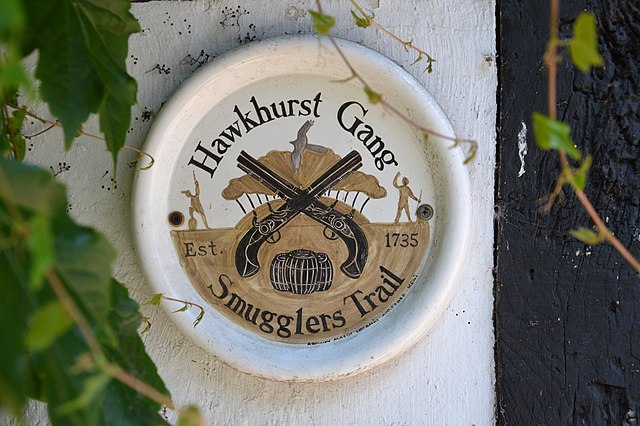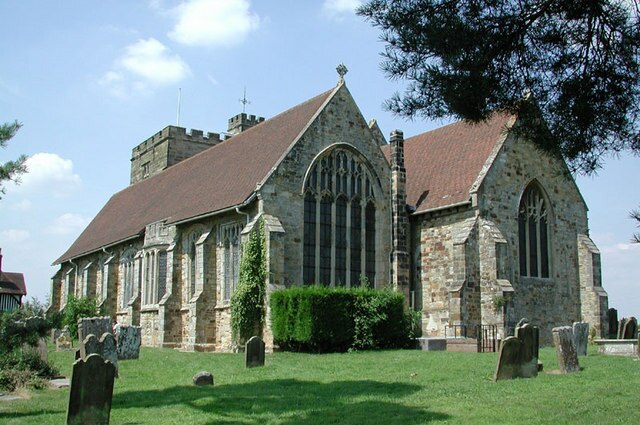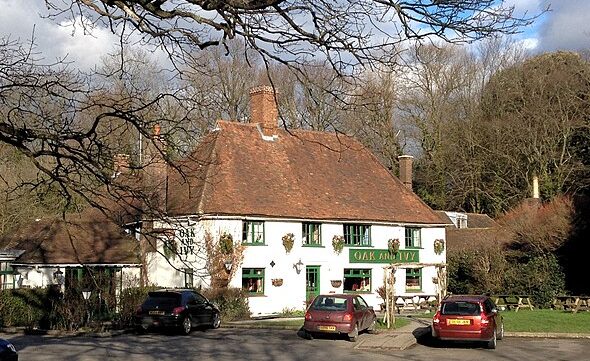For about 14 years, from 1735, parts of southern England were terrorised by one of the most notorious and vicious gangs of smugglers from that oft violent time. Originally based in the village of Hawkhurst, their malign influence spread as far to the west as Dorset.
First listed as the Holkhourst Genge (spelling wasn’t totally standardised then,) their principal headquarters was the Oak and Ivy Inn. They were further established at the Mermaid Inn at Rye, where, we are told, they were so bold that they would sit with their loaded pistols on the table in front of them. They were most assuredly not a clandestine organisation, with large gangs of heavily armed men riding around the countryside quite openly.
It has sometimes been claimed that the gang had a secret network of tunnels for storing their smuggled goods and for hiding from the Customs and Excise men. The truth is that they were so brazen in their activities that such subterfuge was redundant. Instead, they travelled openly between a network of barns and cellars.
Sometimes these hiding places were uncovered. In 1740 Thomas Carswell and his troop of dragoons discovered about 750kg of illicit tea in an Etchingham barn. It was loaded onto a cart, ready to be transported to their Hastings headquarters. Hearing of this, a gang member, James Stanford, gathered up about 30 heavily armed and mounted men. After giving themselves Dutch courage, with copious amounts of (doubtless smuggled) brandy, they tracked the cart and soldiers to Silver Hill near Robertsbridge. The unfortunate Carswell was shot dead, his men captured. Some time later, one of the gang, George Chapman of Hurst Green, was captured, hanged and gibbeted in his home village.

Discretion was never their watchword. Twenty of the gang got drunk at the Mermaid, then moved on to the Red Lion, firing their pistols in the air. Watching them was a young man, James Marshall. Disliking his curiosity, he was captured by them, and was never seen again, dead or alive. Their arrogant boldness is something quite staggering. In 1744 they unloaded smuggled goods from three large ships at Pevensey, carrying them away in a train of some 500 horses, in broad daylight. It was quite apparent that they considered themselves above the law.
Casual violence seems to have been part of the gang’s modus operandi. Jeremiah Curtis joined the gang at some point before 1745, from a notoriously cruel Hastings gang. Richard Hawkins, a farmhand from Walberton, was suspected of stealing two bags of tea from the gang – a valuable and highly taxed commodity. He was brutally questioned at the Dog and Partridge in Slindon. The interview consisted of a severe whipping and beating, from which he died. He then was seen no more, until 1748, when his stone-weighted body was hauled from a lake at Parham Park, the estate of a baronet, Sir Cecil Bishopp, 12 miles away.
Poole, Dorset’s customs house was the gang’s target in October 1747. They had arranged for a shipload of goods worth the substantial sum of £500 (now about £142,000) to be brought in from Guernsey, to be landed near Christchurch. The cargo was 30 hundredweight of tea, 39 barrels of rum and brandy and a small bag of coffee, already taken from another smuggler vessel, the Three Brothers, about a month earlier. The shipment did not go according to plan. On September 22, the Revenue cutter Swift, commanded by Captain William Johnson, intercepted the ship from Guernsey and landed the contraband goods at Poole. The smugglers had managed to escape by small boat.
A Chichester man, Richard Perrin, met a group of local men at Charlton Forest, south of Midhurst. Perrin had been in Guernsey buying the contraband goods. Now he arranged with the men for its recovery. The result was a gang of 30 armed men, including Thomas Kingsmill and probably seven other men from Hawkhurst, riding to Poole to break into the customs house. After resting in the New Forest, they arrived at their target towards 11pm.
They soon realised a major problem was facing them. Literally. A Royal Navy vessel was moored offshore, its guns pointing at the customs house. It seems that the authorities suspected an attempt to regain the goods would be made. The locals panicked and wanted to abandon the plan. The Hawkhurst men wouldn’t give up. They had travelled too far to countenance failure. Then they realised that the problem was going to be solved by nature. As the tide ebbed, the vessel would naturally become lower in the water, meaning that its guns would no longer be ranged on the customs house.
The raid started at around two on the morning of October 8. Their swag was just the tea, abandoning the spirits because they only had horses and no wagons. They got away without incident, although subsequently the Customs Service promised a huge reward, £500, for information leading to the gang’s arrest.
As is so often the case, it was a small thing that was the beginning of the end for the Hawkhurst Gang. A Fordingbridge shoemaker called Daniel Chater was given a small bag of tea by a gang member known as Diamond. Word of the gift spread locally, whether instituted by Chater is not known, but he was summoned as a witness for the Customs Service. He and a rather old Customs officer called William Galley began to travel over to East Marden, a village in the middle of the downs and then rather hard to find. The intention was that Diamond should be reported to the local magistrate, Major Battine.
So remote was East Marden that the pair missed their way, so stopped for a drink at the White Hart in Rowlands Castle. This was, as it turned out, a pub popular with smugglers, and the landlady called in two of them, William Carter and William Jackson, to find out what was happening. Galley and Chater were made drunk and when they fell asleep, Carter and Jackson went through their documents.
The result of the discovery was that the unfortunate Galley and Chater were severely beaten, tied to horses and carted off to the village of Rake, and the Red Lion pub. Here the wretched Galley was buried alive down the earth of a fox, whilst Chater was chained up in a shed for a few days whilst his fate was decided. The decision was inevitable, but he was killed in a particularly vicious way. He was thrown down the well in Lady Holt Park and finished off by being stoned to death.

The mindless thuggery and sheer brutality of the gang finally turned the normally supportive populace against them. In Goudhurst, a former army corporal, William Sturt, known as the General, formed the Goudhurst Band of Militia. The previously mentioned Thomas Kingsmill came from the town. He was furious at what he considered defiance by the normally compliant townspeople and made a threat to kill the residents and burn the place to the ground. On April 21, 1747, Kingsmill led his threatened attack. During the so-called Battle of Goudhurst his brother, George, was one of the first to be killed by gunfire, near St. Mary’s church. Two more died, then the gang retreated, beaten. In 1748, one of the attackers, Arthur Gray, was arrested and charged with “felonious assembly with the intention of carrying away goods on which customs duty had not been paid”. On May 11 of the same year he was hanged at London’s Tyburn, with his body given for dissection by trainee surgeons.
Also in 1748, a government list was published in The London Gazette. It was a list of wanted felons, including those who were involved in the Poole Raid. A substantial reward was offered; £50 for each smuggler captured. Amongst those named was Thomas Lillywhite, husband of Mary, the daughter of Sir Cecil Bishopp, the baronet on whose land an earlier victim of the gang was discovered. Bishopp wrote to the Lord Chief Justice, asking for mercy for his son in law. His lordship wrote back, criticising Bishopp for his action. Lillywhite’s rather flimsy defence was that he only looked after the gang’s horses and had no idea of what was happening. One of his character witnesses was Sir Cecil, and he was acquitted.
Three other members were executed. One, Richard Glover, was found guilty but the jury recommended a pardon, which was given. Jeremiah Curtis escaped to France. Seven more gang members were tried in Chichester and hanged. One of them died in jail before the awful sentence could be carried out. After hanging the bodies were hung in several locations, as a deterrent to others. In total 75 Hawkhurst Gang members were either hanged or sentenced to transportation to the penal colony of Australia. Fourteen of those hanged had their corpse gibbeted. This was usual for murderers but not smugglers. This further indignity shows how seriously the government took their crimes.
Hawkhurst and Goudhurst seem much quieter and law abiding now.
Image Credits: Chris Whippet , Dimi Talen , John Salmon .




What an excellent article! Thanks, Rye News.
Enjoyed reading about my ancestors